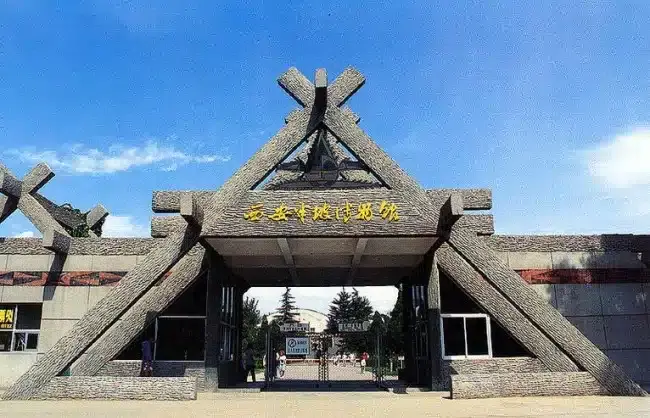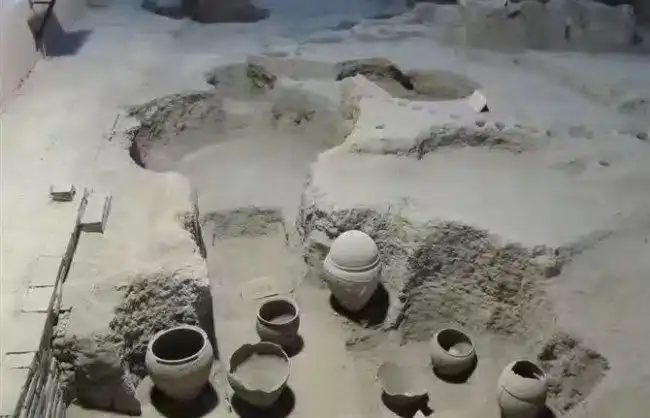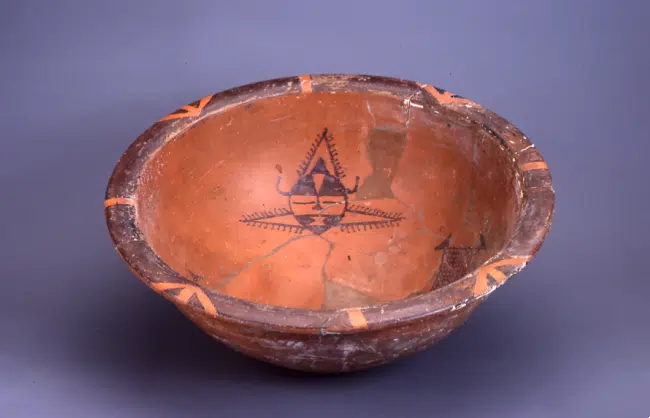Banpo Museum: the Largest Village Ruins of the Neolithic Age in China
Banpo Museum, or Banpo Village Museum, situated east of downtown Xi’an, is a pioneering museum dedicated to the prehistoric period in China. The site was discovered in the spring of 1953, underwent excavation from 1954 to 1957, and had a museum constructed on the original site in 1957.
During the excavation, a wealth of artifacts were unearthed, including g 45 huts, over 200 caves, 6 pottery kiln sites, 250 tombs, and an extensive array of tools, seeds, and agricultural produce. The huts, constructed in round or rectangular shapes, were partially submerged underground, with some built entirely above ground.
The site is known as the largest village ruins from the Neolithic Age in China thus far, offering visitors unparalleled insights into the well-preserved remnants of a matriarchal society in northern China. Arrange your Xi’an tour with a visit here if you are interested in life in a matriarchal society or the prehistoric period.
Useful Travel Information
- Entrance fee:
March 1st- November 30th : RMB 55 per person
December 1st- February28th/ 29th : RMB 45 per person - Opening hours:
March 1st- November 30th : 08:00-17:30
December 1st- February 28th/ 29th : 08:00-17:00 - Advised visiting time: 2 hours
- Public transportation: Bus No 15, 406, 913, 11, 42, etc.
- Location: 155 Banpo Road, Baqiao District, Xi’an City
History Background of Banpo Village
Spanning tens of thousands of years, the primitive society marks the earliest form of human social organization. Like other civilizations in the world, the Chinese nation experiences a period of classless society known as primitive communism.
The Banpo Village ruins, belonging to the Yangshao Culture of the Neolithic Age, represent a complete clan commune of the maternal society in Shaanxi Province’s Guanzhong area which can date back six to seven thousand years. The village was discovered in 1953, covering approximately 50,000 square meters. Only a fifth of the total area has been excavated from 1954 to 1957.

Located on the No. 2 terrace along the eastern bank of the Chan River in Xi’an’s eastern suburbs, the Banpo Ruins enjoyed a favorable climate around 6,000 years ago. Since it was surrounded by dense forests, abundant water, and grasslands during that time, the site was ideal for gathering and hunting. And the fertile soil of the Wei River Plain to its north make it a conducive land for primitive farming. Despite these favorable conditions, collective living was still necessary to combat natural disasters, and achieve survival and progress.
Agricultural production was crucial at Banpo. As women succeeded in finding out the agricultural production, this determined their status in the clan commune. During this transitional period, the management system shifted from communal to paired marriages, leading to uncertainty about paternity among children, who only knew their mothers.
What to See at Banpo Village Museum
The ruins can be classified into three blocks: dwelling district, burial district and pottery kiln district.
The Dwelling District
The dwelling district locates at the center of the ruins and surrounding the dwelling district the villagers dig an occlusive entrenchment to protect villagers from wild animals. The entrenchment is 6-8 meter wide and 5-6 meter deep. The axis of the dwelling district is a little entrenchment which is about 2 meters wide and 1.5 meters deep. In this way the dwellings district falls into two different parts. Outer side to north of occlusive entrenchment is the public burial district. East side of occlusive entrenchment is the pottery-kiln district.
.jpg)
Up to now, there have been more than 40 complete dwelling ruins and over 200 cellars discovered in the dwelling district. In that time, people lived in round dwellings, which looked like a “Mongolian yurt” today. With tile door facing south and cooking-pit in the center, the dwelling is made half underground and the entrance is a declined slope. The people of the Banpo Village already had their fixed sleeping-places and put things in an orderly way.
The houses of later times were built into rectangular shape with doors open to south and the floor be paved with planks. The four sides of the houses were rounded up with big columns, and the center is strengthened with small pikes and boards. The columns and boards were fastened and linked up with cane-strips, and the insides and outsides of the houses were applied with clay-and-grass mortar. This houses of the Banpo Village have beard some characteristics of traditional Chinese buildings. Around the living quarters, there is a big trench of 300 meters in length, 6 -8 meters in width and 5-6 meter in depth. It is probably used for warding off floods or beasts.
Pottery Kiln District
Among the unearthed pottery objects in Banpo Village, 113 carving signs of 22 sorts were found. What do these signs actually mean? Up to now there are still contending opinions. Some say the same sort of signs on the different pottery pieces are probably the signs left by workmen and they do not actually represent any sort of sounds or significance. They were just like those illiterate workmen who carved signs on the pottery pieces to denote what they made.
Others hold that these signs do have some significance and probably they are the rudiments of Chinese characters in its earliest stage. Which is right and which is wrong? Or is there any other argument? It still needs further research. The ancient people of the Banpo Village maybe love their children very much. The dead children were put into pottery jars and covered up with bowls or plates, And still with some holes left on the pottery jars. But why did they leave holes on the burial jars for the dead Children? A possible answer is that the people of Banpo Village believe the holes on jars allow souls of their children to pass through freely.
.jpg)
Burial District
Over 170 burial sites have been discovered in the Burial district, offering a look into the burial practices of a matriarchal society. In this district, adults are commonly seen buried flat on their backs with their limbs being straightened. Two tombs stand out among others, one tomb with four females and another with two males, indicating communal burials during that time. Other burial variations are also found here, including secondary burials, bodies being buried upside down or with bent legs.
Children were commonly interred in urns. A little girl’s tomb is notable, where beautiful burial items were found, and there is a wooden board to support here body.

Unique Artifacts at Banpo Village Museum
The artifacts unearthed in Banpo Village show some unique characteristics. Most stonewares were grind into specific shapes, many bone objects has exquisite craftsmanship. Pottery items are commonly made from brown or dark brown clay, and are adorned with geometric, animal, or floral patterns, earning them the name “colored pottery.”
As an important aspect of the Yangshao Culture, the Banpo Ruins in Xi’an unearthed a variety of earthenware used by its inhabitants. Visitors can expect to witness their food containers like bowls, plates, urns, cups, pans, and other utensils, water containers like water jars, narrow-necked pots, and gourd-shaped vessels, and cooking pots, pottery bottles, and artistic earthenware pieces, etc.
The potteries unearthed in Banpo ruins were commonly painted with vivid fish and deer, and often adorned with water waves and plant patterns, indicating their ability to move from realistic to expressive art. An intriguing artifact is a bowl that is adorned with a pattern of a human head atop a fish’s body with an open mouth. The pattern is still a puzzle, some scholars suggest it symbolizes hopes for a bountiful fishing haul, while others interpret it as reflecting mystical religious beliefs.
The Banpo people also processed the weaving skills, they used jute or animal fibers and bone needles to make clothes, and made mats and baskets with reeds, bamboo, and rattan strips.










